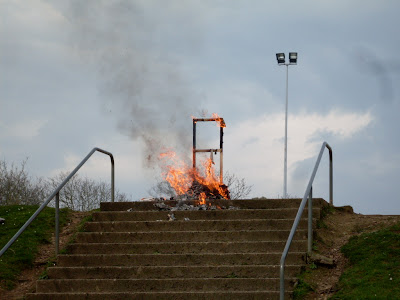As I mentioned before, Carnival in Galicia is especially well-known in Spain. Of all the places where Entroido is celebrated, the region of Ourense is, according to everyone I've met here, one of the most unique, and traditionally unruly places to celebrate before Lent. Three small villages (and yes, I mean TINY villages) in particular, Verín, Laza, and Xinzo de Limia are the most widely known for the outrageous celebrations they have there. Each town maintains a unique tradition, with their own forms of street performance, traditional foods, and general debauchery.
We started in Xinzo, where the narrow stone streets were full of people in elaborate costumes, most of which looked like they had been out and about for at least three days. They never stop celebrating here. What's unique about Xinzo are the Pantallas. They are more or less jesters that run through the town, dressed in traditional outfits, with goat bells around their hips to make noise, yielding inflated, hardened pig bladders and banging them together to animate the crowd. The general mayhem cannot be explained in its entirety, nor can I describe the odd, unsettled feeling that the masked Pantallas banging pigs bladders together left me with, but I hope the photos below and the little video will help give you an idea.


And these were some of our favorites non-traditional costumes:
 This mime troupe was incredible. They played music, and would stop, hold the pose, and freeze entirely before continuing on through the crowd. Brilliant.
This mime troupe was incredible. They played music, and would stop, hold the pose, and freeze entirely before continuing on through the crowd. Brilliant.
This is the cocido we had at a hole-in the wall place. Traditional in Ourense on Carnival. Came with garbanzos and cooked cabbage. MMMM. Oh, and the piece of meat with the bone in the middle is in fact pork tail. We asked. That one was a little much.

We stayed in Verín for the night, where the local festivity was a giant flour fight in the town's central plaza. Absolutely wonderful. Kaydin and I missed the brunt of it, but arrived in time for some good flour-throwing and music. Unfortunately, the only photo I have of the experience is of the aftermath of the evening (the face paint was there beforehand, don't worry):

Next day, we headed to Laza, the infamous town of the Peluqueiros. The Peluqueiros are basically the jokers and tricksters that run through the town riling up people similar to the Pantallas, but they're known to throw horse poop, flour and ants -- yes, LIVE red ants at the spectators. We were warned to wear protective clothing and always keep an eye out. They also apparently wield giant Spanish broom branches, full of thorns, and will smack people with them if they don't look out. So yes, needless to say, I was extremely excited, and my companions were a bit leery.
We arrived at lunch time, and the town's small parade, complete with donkeys and carts, was pulling into the local bar so the participants could enjoy some wine and pulpo before heading back out. We then followed them into town, where Ali was immediately smacked in the face with a dirty rag slung at her by a welcoming local. She was too clean apparently.
Me, Ali, and Rachel:

Parade:

Burros!


Pulpo!

Central Plaza: full of all sorts of slingings of various things. No ants though.....How fun!

After this, Kaydin and I headed south toward Madrid to catch a plane to Carnival in the Canary Islands. Just for the contrast I suppose. Next post will be all about that. :-) Signing off for now.

































